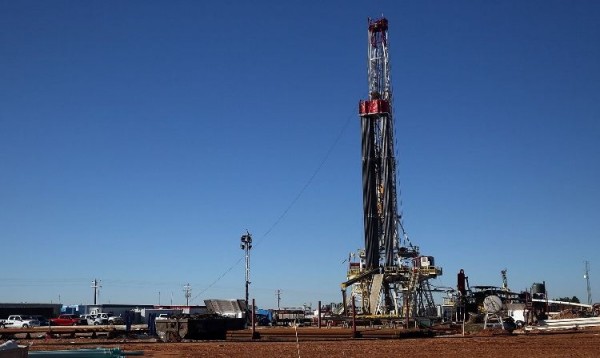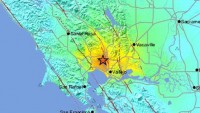‘Earthshaking” Study Links Earthquakes to Fracking
| Arthur Dominic Villasanta | | Sep 23, 2016 05:35 PM EDT |
(Photo : Getty Images) Fracking operation in Texas.
Using satellite data, scientists from Stanford University confirm the controversial method of extracting oil called fracking or hydraulic fracturing popular in the United States does trigger earthquakes.
They found the largest recorded earthquake in East Texas in 2012 was triggered by the high-volume injections of wastewater from oil and gas activities deep underground during fracking operations.
Like Us on Facebook
These operations set-off a 4.8 magnitude earthquake that rattled residents and damaged buildings in East Texas, said a study co-authored by Stanford geophysicist William Ellsworth at Stanford's School of Earth, Energy & Environmental Sciences.
The study, titled "Surface uplift and time-dependent seismic hazard due to fluid injection in eastern Texas," was published in this week's issue of the journal, Science. It highlights the importance of understanding the local geology for wastewater injection operations.
Fracking is a well-stimulation technique in which rock is fractured or split by a pressurized liquid. The process involves the high-pressure injection of fracking fluid (primarily wastewater) into a wellbore to create cracks in the deep-rock formations through which natural gas, petroleum and brine will flow more freely.
Geophysicists have long suspected the 2012 temblor, which was the largest ever recorded in the region and followed by several strong aftershocks, was a man-made, or "induced," quake resulting from the activities of nearby wastewater injection wells, but definitive proof had been lacking -- until now.
"Our research is the first to provide an answer to the questions of why some wastewater injection causes earthquakes, where it starts and why it stops," said Ellsworth.
Ellsworth and his co-authors used a remote sensing technique called Interferometric Synthetic Aperture Radar (InSAR) to measure ground deformations near the wells in East Texas where the quake occurred. InSAR satellites use radar to detect tiny, centimeter-scale changes in the shape of Earth's surface.
"Our study reports on the first observations of surface uplift associated with wastewater injection," said Ellsworth. "The detection of uplift when combined with well-injection records provides a new way to study wastewater injection."
The team focused on four high-volume wells used for disposing wastewater. These wells are located near the town of Timpson, Texas where the 2012 quake was centered.
The four wells began operations between 2005 and 2007 and at their peak injected about 200 million gallons of wastewater per year underground.
Brackish water naturally coexists with oil and gas within the Earth. After extracting this slurry using hydraulic fracturing or other techniques, drilling companies separate the "produced water" from the oil and gas and then reinject it into Earth at disposal wells.
Some180,000 of these disposal wells are currently in operation in the U.S., primarily in Texas, California, Oklahoma and Kansas.
"You can think of the wastewater as ancient ocean water," said Ellsworth. "It's too salty and too contaminated with other chemicals to treat economically, so the only viable solution at present is to put it back underground."
But where that wastewater is injected can make a huge difference. Injecting wastewater at a depth of over one mile, two of the wastewater disposal wells the scientists examined lie directly above where the earthquake occurred. The other two wells injected similar volumes of wastewater, but at shallower depths, just over a half mile below the surface.
The InSAR measurements revealed that wastewater injection at the shallow wells resulted in detectable ground uplift up to eight kilometers away.
"Moving forward, we need to predict where pressures will increase in order to reduce the potential for inducing earthquakes," Ellsworth said. "Our research uncovers new possibilities for operating wells in ways that reduce earthquake hazard."
Additional authors on the study include Manoochehr Shirzaei of Arizona State University's School of Earth and Space Exploration; Kristy Tiampo of the Cooperative Institute for Research in Environmental Sciences, University of Colorado Boulder; Pablo González of the University of Liverpool (UK) and Michael Manga of the University of California, Berkeley.
Tagsfracking, Hydraulic fracturing, earthquakes, Stanford University, East Texas, William Ellsworth
©2015 Chinatopix All rights reserved. Do not reproduce without permission
EDITOR'S PICKS
-

Did the Trump administration just announce plans for a trade war with ‘hostile’ China and Russia?
-

US Senate passes Taiwan travel bill slammed by China
-

As Yan Sihong’s family grieves, here are other Chinese students who went missing abroad. Some have never been found
-

Beijing blasts Western critics who ‘smear China’ with the term sharp power
-

China Envoy Seeks to Defuse Tensions With U.S. as a Trade War Brews
-

Singapore's Deputy PM Provides Bitcoin Vote of Confidence Amid China's Blanket Bans
-

China warns investors over risks in overseas virtual currency trading
-

Chinese government most trustworthy: survey
-

Kashima Antlers On Course For Back-To-Back Titles
MOST POPULAR
LATEST NEWS
Zhou Yongkang: China's Former Security Chief Sentenced to Life in Prison

China's former Chief of the Ministry of Public Security, Zhou Yongkang, has been given a life sentence after he was found guilty of abusing his office, bribery and deliberately ... Full Article
TRENDING STORY

China Pork Prices Expected to Stabilize As The Supplies Recover

Elephone P9000 Smartphone is now on Sale on Amazon India

There's a Big Chance Cliffhangers Won't Still Be Resolved When Grey's Anatomy Season 13 Returns

Supreme Court Ruled on Samsung vs Apple Dispute for Patent Infringement

Microsoft Surface Pro 5 Rumors and Release Date: What is the Latest?














